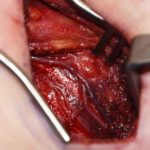
For rib removal the risks and complications can be classified as scars, temporary vs.permanent pain, pneumothorax and the overall effectiveness of the procedure.
Rib removal requires incisions whose placement varies based on what exact ribs are being removed. Thus there will be scars whose lengths will be anywhere from 6 to 8cms. A single incision can usually only remove two ribs to which it is closest. While a subcuticular wound closure is always done and the scars do heal in a very linear and fine line fashion, where they have to be placed is anything but in a concealed location. The good news is that the incisions are placed parallel to the relaxed skin tensions lines of the torso (which is very good for ensuring the best scar) but their location is ‘out in the open’ so to speak.

Just inside the ribs lies the pleural lining which creates an air sac around the lung. One of the major objectives of the surgery is to avoid violation of this thin and friable thoracic wall lining technically known as the parietal pleura. An intact parietal pleura allows the contraction of the diaphragm to creates a negative pressure within the pleural cavity which forces the lungs to expand for inhalation and exhalation. If the pleural lining gets violated air will enter the pleural space, known as a pneumothorax. This negates the negative pressure and the lung can ‘collapse’. Pleural violations are always a risk with any rib harvest/removal procedure and occasionally it does occur. When encountered intraoperatively the air is sucked out of the pleural cavity and the hole closed. A chest x-ray after surgery will check whether any residual air remains and that the lung is properly inflated. In rare cases, a chest tube may be needed after surgery if a lot of residual air remains so the lung can expand fully.
The potential risk of pneumothorax is directly related to the location of the pleural lining to the ribs. The lungs and the pleural lining inside the ribcage does not encompass all ribs. Anteriorly the pleural is not encountered until the bottom of the seventh rib is approached. Posteriorly the level of the pleura angles downward as it goes more into the back. Rib removals 9 and 10 place it at some risk of being encountered.
Lastly how effective can rib removal be at waistline narrowing? That depends on proper identification of the ribs before surgery that can best remove the outward obstruction. Even with properly identified rib segments, some patients may still not achieve their ideal waistline shape. Only so many rib segments can be safely removed.
Dr. Barry Eppley
Indianapolis, Indiana


